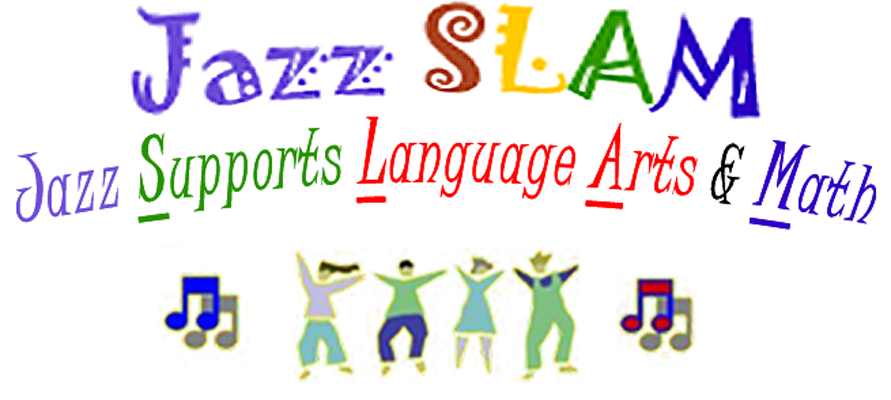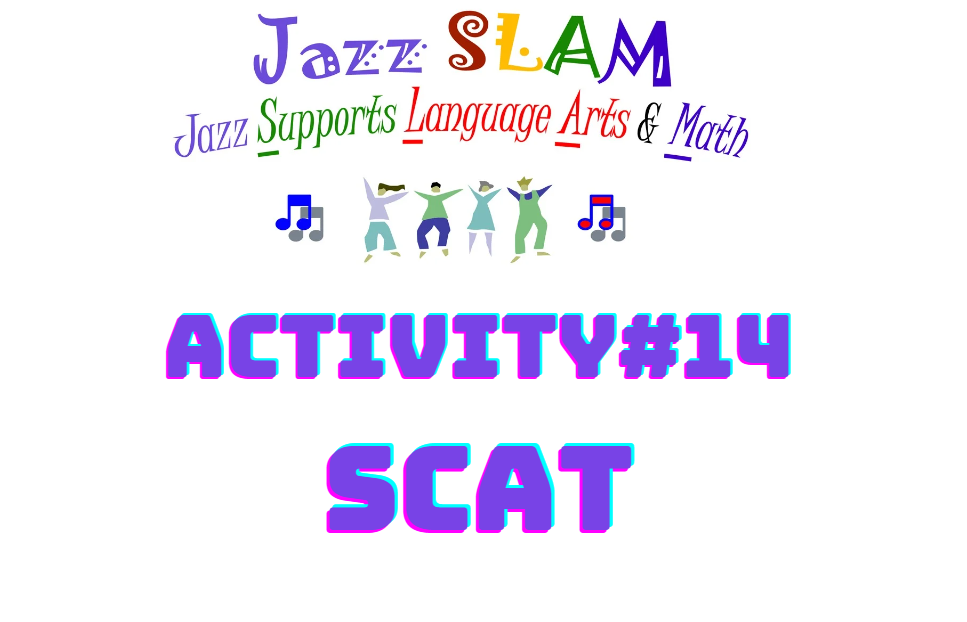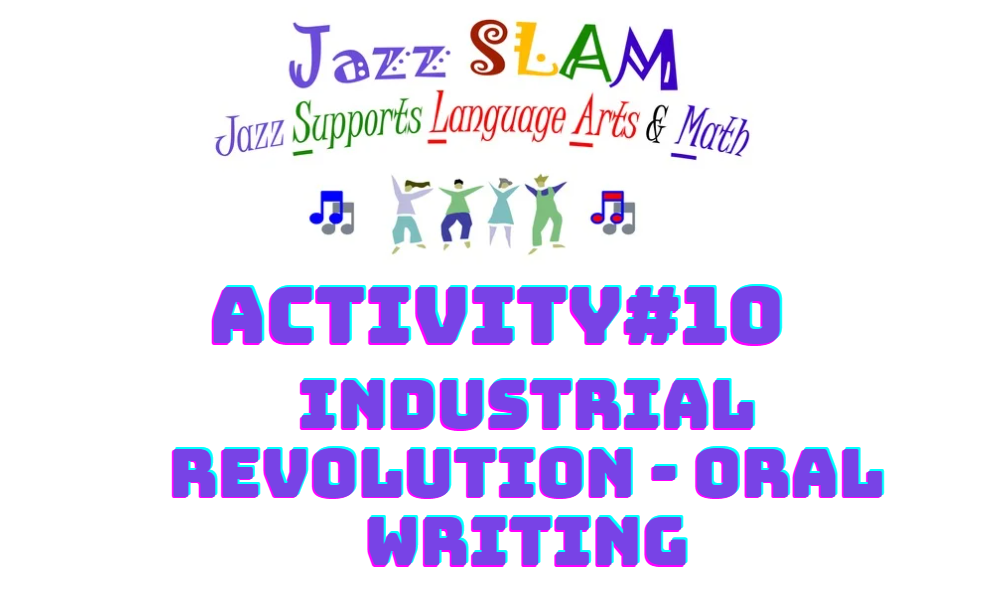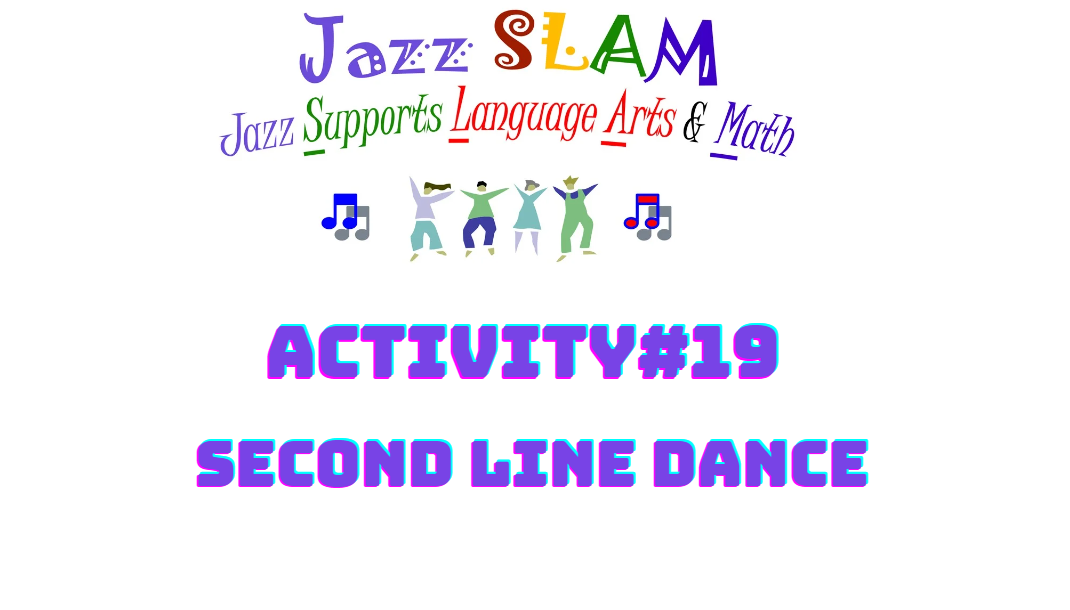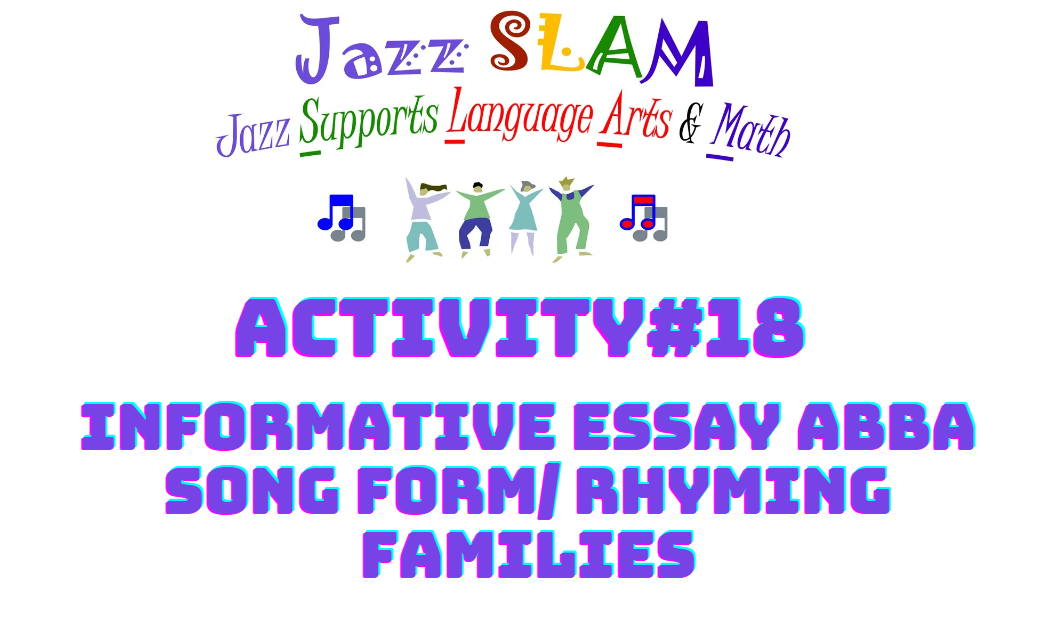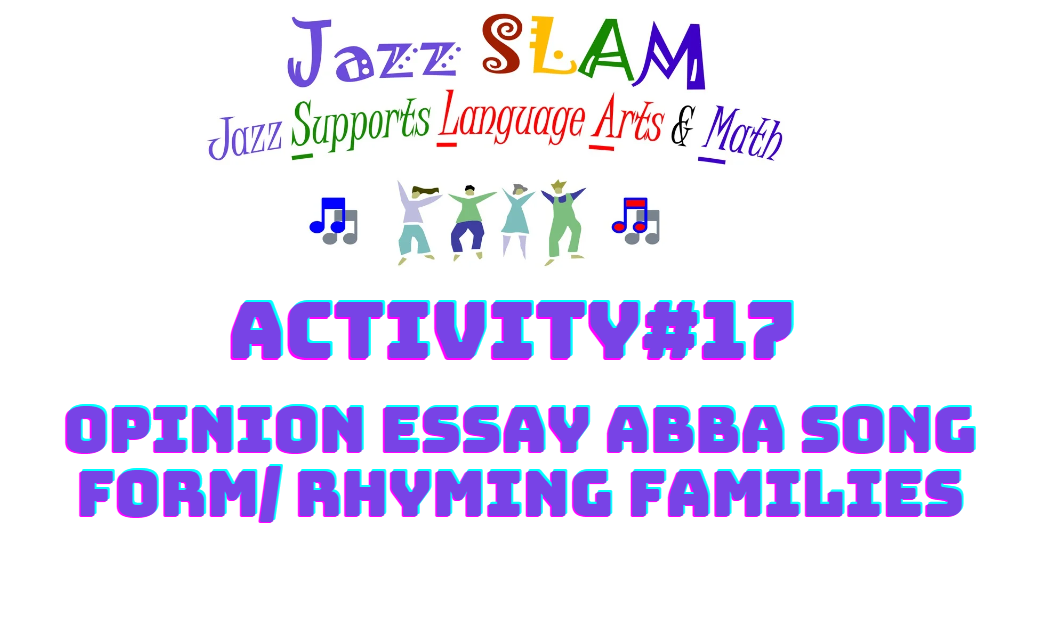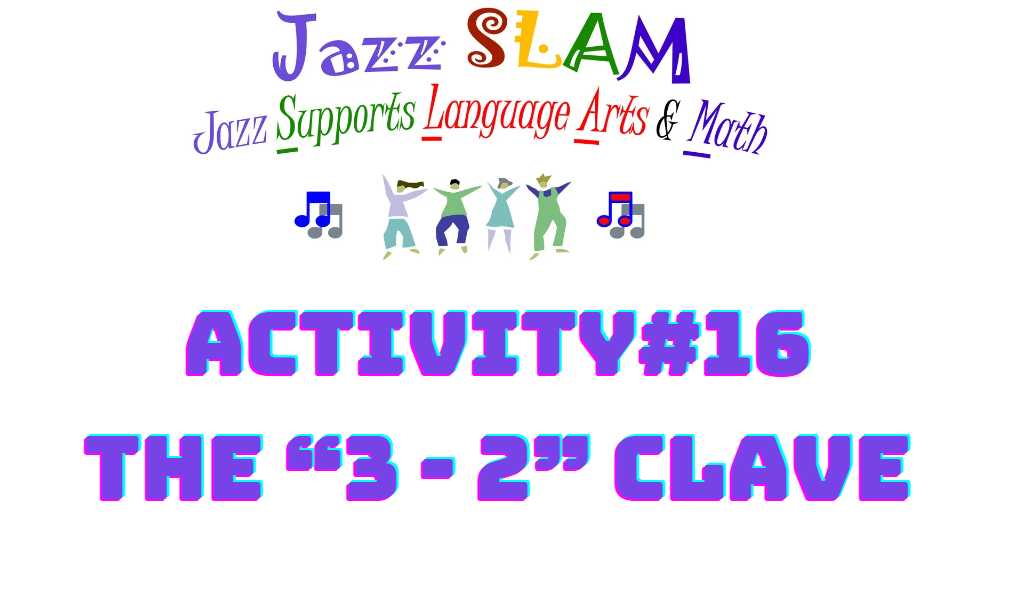About This Lesson
Learning Goals/Objectives
STUDENTS WILL BE ABLE TO:
- Define “scat”
- Identify and describe AABA form
- Perform a scat to I Got Rhythm
Materials/Additional Resources
Common Core Standards & NGSSS Music Standards
Common Core Standards
RL.3.1 Ask and answer questions to demonstrate understanding of a text, referring explicitly to the text as the basis for the answers.
RL.3.2 Recount stories, including fables, folktales, and myths from diverse cultures; determine the central message, lesson, or moral and explain how it is conveyed through key details in the text.
RL.3.3 Describe characters in a story (e.g., their traits, motivations, or feelings) and explain how their actions contribute to the sequence of events.
RL.3.5 Refer to parts of stories, dramas, and poems when writing or speaking about a text, using terms such as chapter, scene, and stanza; describe how each successive part builds on earlier sections.
RF.3.4 Read with sufficient accuracy and fluency to support comprehension
RI.3.1 Ask and answer questions to demonstrate understanding of a text, referring explicitly to the text as the basis for the answers.
RL.3.3 Describe characters in a story (e.g., their traits, motivations, or feelings) and explain how their actions contribute to the sequence of events.
SL.3.1 Engage effectively in a range of collaborative discussions (one-on-one, in groups, and teacher-led) with diverse partners on grade 3 topics and texts, building on others’ ideas and expressing their own clearly
SL.3.2 Determine the main ideas and supporting details of a text read aloud or information presented in diverse media and formats, including visually, quantitatively, and orally.
SL.3.4 Report on a topic or text, tell a story, or recount an experience with appropriate facts and relevant, descriptive details, speaking clearly at an understandable pace.
SL.3.5 Demonstrate fluid reading at an understandable pace, adding visual displays and engaging audio recordings when appropriate to emphasize or enhance certain facts or details
L.4.1 Demonstrate command of the conventions of standard English grammar and usage when writing or speaking.
L.4.3 Use knowledge of language and its conventions when writing, speaking, reading, or listening
L.4.5 Demonstrate understanding of word relationships, and nuances in word meanings.
RI.4.5 Describe the overall structure (e.g., chronology, comparison, cause/effect, problem/solution) of events, ideas, concepts, or information in a text or part of a text.
RI.4.7 Interpret information presented visually, orally, or quantitatively (e.g., in charts, graphs, diagrams, time lines, animations, or interactive elements on Web pages) and explain how the information contributes to an understanding of the text in which it appears
RI.4.10 By the end of the year, read and comprehend informational texts, including history/social studies, science, and technical texts, at the high end of the grades 4–5 text complexity band independently and proficiently.
RL.4.5 Explain major differences between poems, drama, and prose, and refer to the structural elements of poems (e.g., verse, rhythm, meter) and drama (e.g., casts of characters, settings, descriptions, dialogue, stage directions) when writing or speaking about a text.
SL.4.2 Paraphrase portions of a text read aloud or information presented in diverse media and formats, including visually, quantitatively, and orally.
L.5.1 Demonstrate command of the conventions of standard English grammar and usage when writing or speaking.
L.5.2 Demonstrate command of the conventions of standard English capitalization, punctuation, and spelling when writing. L.5.3 Use knowledge of language and its conventions when writing, speaking, reading, or listening
L.5.5 Demonstrate understanding of figurative language, word relationships, and nuances in word meanings.
RI.5.5 Compare and contrast the overall structure (e.g., chronology, comparison, cause/effect, problem/solution) of events, ideas, concepts, or information in two or more texts.
RI.5.7 Draw on information from multiple print or digital sources, demonstrating the ability to locate an answer to a question quickly or to solve a problem efficiently.
RI.5.10 By the end of the year, read and comprehend informational texts, including history/social studies, science, and technical texts, at the high end of the grades 4–5 text complexity band independently and proficiently.
RL.5.2 Determine a theme of a story, drama, or poem from details in the text, including how characters in a story or drama respond to challenges or how the speaker in a poem reflects upon a topic; summarize the text.
RL.5.4 Determine the meaning of words and phrases as they are used in a text, including figurative language such as metaphors and similes.
RL.5.5 Explain how a series of chapters, scenes, or stanzas fits together to provide the overall structure of a particular story, drama, or poem
SL.5.2 Summarize a written text read aloud or information presented in diverse media and formats, including visually, quantitatively, and orally.
SL.6.1 Engage effectively in a range of collaborative discussions (one-on-one, in groups, and teacher-led) with diverse partners on grade 6 topics, texts, and issues, building on others’ ideas and expressing their own clearly.
L.6.2 Demonstrate command of the conventions of standard English capitalization, punctuation, and spelling when writing
NGSSS Music Standards
MU.3.C.2.1Evaluate performances of familiar music using teacher-established criteria.
MU.3.F.1.1 Enhance the meaning of a story or poem by creating a musical interpretation using voices, instruments, movement, and/or found sounds.
MU.3.H.3.1Experience and discuss, using correct music and other relevant content-area vocabulary, similarities in the use of pattern, line, and form in music and other teacher selected contexts.
MU.3.O.3.1 Describe how tempo and dynamics can change the mood or emotion of a piece of music. MU.3.S.1.1 Improvise rhythms or melodies over ostinato.
MU.3.S.2.1 Identify patterns in songs to aid the development of sequencing and memorization skills.
MU.4.C.2.2 Critique specific techniques in one's own and others performances using teacher established criteria.
MU.4.F.1.1 Create new interpretations of melodic or rhythmic pieces by varying or adding dynamics, timbre, tempo, lyrics, and/or movement.
MU.4.F.3.1 Identify the characteristics and behaviors displayed by successful student musicians and discuss how these qualities will contribute to success beyond the music classroom.
MU.4.H.3.1 Identify connections among music and other contexts, using correct music and other relevant content-area vocabulary, and explore how learning in one academic area can help with knowledge or skill acquisition in a different academic area.
MU.4.O.3.1 Identify how expressive elements and lyrics affect the mood or emotion of a song.
MU.4.S.1.1 Improvise phrases, using familiar songs.
MU.4.S.1.3 Arrange a familiar song for voices or instruments by manipulating form.
MU.4.S.2.1 Describe changes, using correct music vocabulary, in one's own and/or others performance over time.
MU.5.C.2.2 Describe changes, using correct music vocabulary, in one's own and/or others performance over time.
MU.5.F.1.1 Create a performance, using visual, kinesthetic, digital, and/or acoustic means to manipulate musical elements.
MU.5.F.3.1 Examine and discuss the characteristics and behaviors displayed by successful student musicians that can be applied outside the music classroom.
MU.5.H.3.1 Examine critical-thinking processes in music and describe how they can be transferred to other disciplines.
MU.5.O.3.1 Examine and explain how expressive elements, when used in a selected musical work, affect personal response.
MU.4.S.1.1 Improvise phrases, using familiar songs.
MU.5.S.1.3 Arrange a familiar song by manipulating specified aspects of music.
MU.5.S.2.1 Use expressive elements and knowledge of musical structure to aid in sequencing and memorization and to internalize details of rehearsals and performance.
MU.68.C.2.1 Critique personal performance, experiment with a variety of solutions, and make appropriate adjustments with guidance from teachers and peers.
MU.68.C.2.2 Critique, using correct music vocabulary, changes in one’s own or others’ musical performance resulting from practice or rehearsal.
MU.68.C.2.3 Critique personal composition and/or improvisation, using simple criteria, to generate improvements with guidance from teachers and/or peers.
MU.68.F.1.1 Create a composition and/or performance, using visual, kinesthetic, digital, and/or acoustic means to manipulate musical elements.
MU.68.F.3.3 Identify the tasks involved in the compositional process and discuss how the process might be applied in the work place.
MU.68.O.2.1 Create a composition, manipulating musical elements and exploring the effects of those manipulations.
MU.68.O.3.1 Describe how the combination of instrumentation and expressive elements in a musical work can convey a specific thought, idea, mood, and/or image.
MU.68.S.1.1 Improvise rhythmic and melodic phrases to accompany familiar songs and/or standard harmonic progressions.
MU.68.S.1.3 Arrange a short musical piece by manipulating melody, form, rhythm, and/or voicing.
MU.68.S.2.1 Perform music from memory to demonstrate knowledge of the musical structure.
ESOL/ESE STRATEGIES
Steps
Step 1:
Have your students make up silly nonsense syllables to “Scat” to “I Got Rhythm.”
Step 2:
You can use this I’ve Got Rhythm-Karaoke version for them to scat to. Each scat you sing should be 2 bars for beginners to learn the form. (Note start scatting the A-A-B-A form after the 8 bar Intro, ie. start singing at 0:14.)
Step 3:
- Sing through the whole form with you scatting:
- 1st“A:” you scat for 2 bars, then they repeat it for 2 bars. You scat for 2morebars, they repeat it
- 2nd“A:” you scat for 2 bars, then they repeat it for 2 bars. You scat for 2 more bars, they repeat it
- B:you scat for 2 bars, then they repeat it for 2 bars. You scat for 2 more bars, they repeat it.
- 3rd& last “A:”you scat for 2 bars, then they repeat it for 2 bars. You scat for 2 more bars, they repeat it
Rubric/Instrument for Assessment
4 Points(Advanced):
A score of four is a response in which the student demonstrates a thorough understanding of the concepts and/or procedures embodied in the task. The student has responded correctly to the task, used sound procedures, and provided clear and complete explanations and interpretations.
3 Points(Proficient):
A score of three is a response in which the student demonstrates an understanding of the concepts and/or procedures embodied in the task. The students’ response to the task is essentially correct with the procedures used and the explanations and interpretations provided demonstrating an essential but less than thorough understanding. The response may contain minor flaws that reflect in attentive execution of procedures or indications of some misunderstanding of the underlying concepts and/or procedures.
2 Points(Basic):
A score of two indicates that the student has demonstrated only a partial understanding of the concepts and/or procedures embodied in the task. Although the student may have used the correct approach to obtaining a solution or may have provided a correct solution, the students’ work lacks an essential understanding of the underlying concepts.
1 Point(Emerging):
A score of one indicates that the student has demonstrated a very limited understanding of the concepts and/or procedures embodied in the task. The students’ response is incomplete and exhibits many flaws. Although the students’ response has addressed some of the conditions of the task, the student reached an inadequate conclusion and/or provided reasoning that was faulty or in complete. The response exhibits many flaws or may be incomplete.
0 Points:
A score of zero indicates that the student has provided a completely incorrect or non-interpretable response or no response at all.




